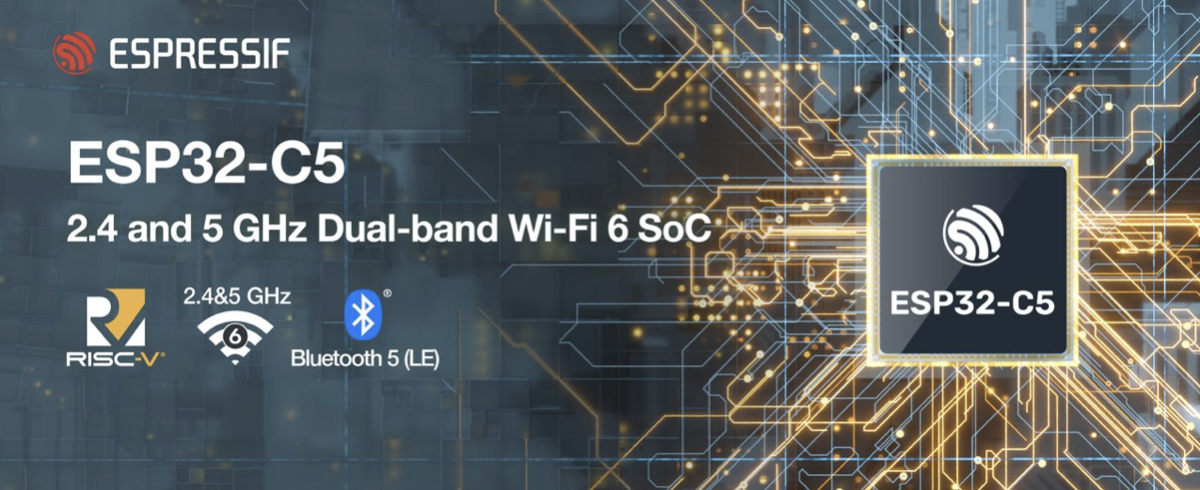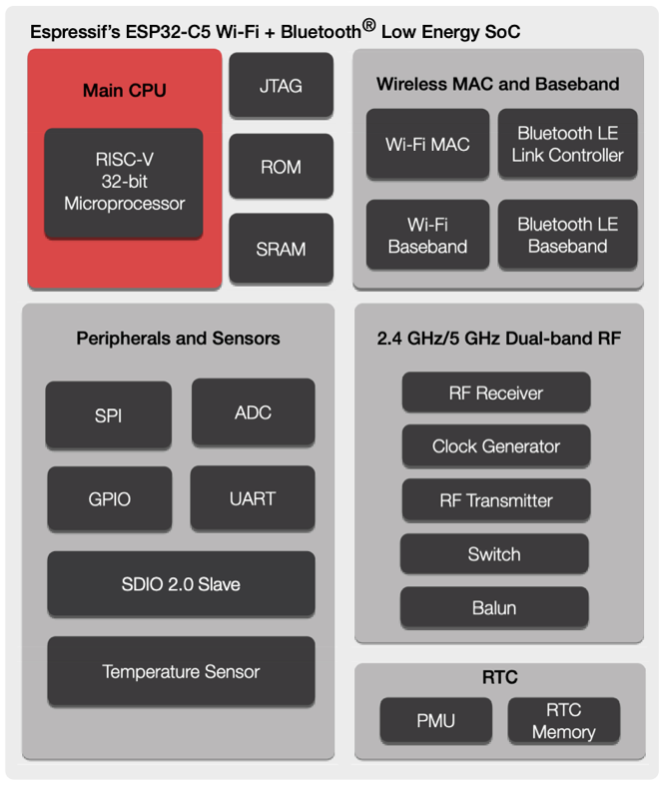- Home
- Hardware
- SDKs
- Cloud
- Solutions
- Support
- Ecosystem
- Company
- Contact
news
Introducing ESP32-C5: Espressif’s first Dual-Band Wi-Fi 6 MCU
Shanghai, China
Jun 20, 2022
Espressif’s ESP32-C5 is the industry’s first RISC-V SoC solution that supports 2.4 and 5 GHz dual-band Wi-Fi 6, along with Bluetooth LE. It is designed for applications that require a high-efficiency wireless transmission.

Espressif Systems (SSE: 688018.SH) announces today the release of ESP32-C5, a highly integrated MCU with 2.4 and 5 GHz dual-band Wi-Fi 6, as well as Bluetooth 5 (LE) connectivity. The ESP32-C5 enriches Espressif’s Wi-Fi 6 solutions as a follow-up to the ESP32-C6 SoC, which was announced last year.
ESP32-C5 packs a dual-band Wi-Fi 6 (802.11ax) radio, along with the 802.11b/g/n standard for backward compatibility. The Wi-Fi 6 support is optimised for IoT devices, as the SoC supports a 20MHz bandwidth for the 802.11ax mode, and a 20/40MHz bandwidth for the 802.11b/g/n mode.
ESP32-C5 has a 32-bit, RISC-V, single-core processor which can clock up to 240 MHz in speed. It has a 400KB SRAM, 384KB of ROM, and it works with external flash. It has more than 20 programmable GPIOs, while supporting all the commonly-used peripheral and the best-in-class security features. Also included is an SDIO 2.0 Slave interface.

ESP32-C5 Block Diagram
The support for the 5GHz band provides customers with a more stable and low-latency wireless connectivity in cases where less traffic and lower interference are needed for critical applications. It gives end-users the option of assigning different IoT devices to different networks, according to the criticality of the devices in hand. The 5GHz band also supports hosts of high throughput applications, such as live-streaming devices, Wi-Fi dongles, IP Cameras, etc. By integrating a dual-band connectivity into their devices, customers may enjoy maximum flexibility, while future-proofing their solutions.
The 802.11ax standard (Wi-Fi 6) used in ESP32-C5 contains a variety of added features which provide concrete benefits for IoT devices. For example, ESP32-C5 supports the OFDMA (Orthogonal Frequency Division Multiple Access) mechanism for both uplink and downlink communications, as well as the MU-MIMO capability for downlink. Both of these features enable high efficiency and low latency in congested wireless environments, while also improving connectivity in high density environments. Another important feature of the 802.11ax standard is the Target Wake Time (TWT), which allows devices to sleep for an extended time-period, with assistance from an 802.11ax-capable Wi-Fi access point. This feature makes possible the use of ESP32-C5 in battery-operated devices that can last for years, while staying connected non-stop.
ESP32-C5 is supported on Espressif’s open-source ESP-IDF, which already powers millions of devices in the field. This ensures the availability of a robust SDK and tools, as well as an easy application migration path for developers. For customers who would like to use ESP32-C5 as a communication co-processor with an external host, ESP-AT and ESP-Hosted SDKs are available, too. ESP-AT provides a simple AT command-based interface for MCU hosts, whereas ESP-Hosted provides a standard 802.11 interface for Linux hosts.
If you wish to learn more about ESP32-C5, please contact our customer support team, who will get back to you as soon as possible.


 LinkedIn
LinkedIn 微信
微信
 Twitter
Twitter Facebook
Facebook
